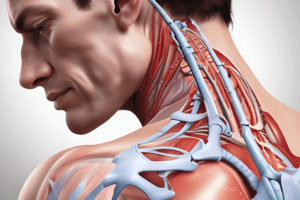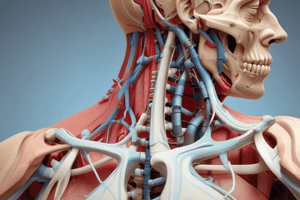Podcast
Questions and Answers
What is the typical shoulder stroke rate for males in swimming?
What is the typical shoulder stroke rate for males in swimming?
9,900 strokes/week
What is the typical shoulder stroke rate for females in swimming?
What is the typical shoulder stroke rate for females in swimming?
16,500 strokes/week
What happens in Stage I of impingement syndrome?
What happens in Stage I of impingement syndrome?
Edema and inflammation
Which of the following structures can be compressed during arm elevation in shoulder impingement syndrome? (Select all that apply)
Which of the following structures can be compressed during arm elevation in shoulder impingement syndrome? (Select all that apply)
In Stage III of impingement syndrome, patients may experience __________.
In Stage III of impingement syndrome, patients may experience __________.
What is the typical age range for Stage II of impingement syndrome?
What is the typical age range for Stage II of impingement syndrome?
Type III Acromion is flat.
Type III Acromion is flat.
What common shoulder test assesses for rotator cuff tears?
What common shoulder test assesses for rotator cuff tears?
What is the role of the scapular upward rotation during shoulder abduction?
What is the role of the scapular upward rotation during shoulder abduction?
What is the recommended grade of evidence for eccentric rotator cuff training?
What is the recommended grade of evidence for eccentric rotator cuff training?
Match the following tests with their purpose:
Match the following tests with their purpose:
Flashcards are hidden until you start studying
Study Notes
Swimming Practice and Shoulder Strokes
- Swimming practice involves 8000-12000 meters per training session.
- Athletes typically train 2 times a day, 5-7 days a week.
- Males average 9,900 strokes per week per shoulder; females average 16,500 strokes.
Impingement Syndrome
- Impingement syndrome is caused by compression of the:
- Rotator cuff
- Subacromial bursae
- Biceps tendon
- This compression occurs against the acromion and coracoacromial ligament during arm elevation.
Theories on Impingement and Injury
- Vascular Theory: Compression in the critical Codman zone leads to cell death.
- Mechanical Theory: Degenerative tendons rupture at lower loads due to increased stress concentrations.
- Neurological Theory: Degeneration of nerve fibers results in reduced proprioceptive feedback.
Stages of Impingement
- Stage I: Edema, inflammation, and tendinitis (common in individuals under 25).
- Stage II: Fibrosis, reversible activity modification needed (ages 25-40).
- Stage III: Bone spurs and irreversible tendon ruptures (common in individuals over 40).
Structural Factors Influencing Impingement
- Acromion shapes:
- Type I: Flat (17%)
- Type II: Curved (43%)
- Type III: Hooked (39%)
- Type IV: Convex (1%)
- Other factors: Bone spurs, os acromiale variants, and coracoacromial ligament structures.
Mechanical Influences
- Overuse of the rotator cuff can lead to posterior internal impingement and muscle imbalance.
- Scapular dyskinesis can result from weak muscles like the lower trapezius.
Scapular Movement and Dysfunction
- Scapular winging can occur due to:
- Trapezius palsy
- Serratus anterior palsy
- Scapular dyskinesis may lead to decreased glenohumeral joint stability and reduced subacromial space.
Kinematics During Abduction
- Early Phase (0-90 degrees):
- SC Joint: 25° elevation
- AC Joint: 5° upward rotation
- Scapulo-thoracic Joint: 30° upward rotation
- GH Joint: 60° abduction
- Late Phase (90-180 degrees):
- SC Joint: 5° elevation and 35° posterior rotation
- AC Joint: 25° upward rotation
- GH Joint: 60° abduction.
Muscular Considerations
- Tonic and Phasic System:
- Tonic muscles: prone to tightness (e.g., pectoralis).
- Phasic muscles: prone to weakness (e.g., middle trapezius).
Assessment Tools
- Common tests for impingement and rotator cuff integrity include:
- Neer’s impingement test
- Hawkins-Kennedy test
- Supraspinatus test (Empty can test)
- Lift-off sign for subscapularis assessment.
Treatment Recommendations
- Evidence supports the use of:
- Eccentric rotator cuff training.
- Manual therapy techniques.
- Scapula taping to reduce upper trapezius activity, with Kinesio taping showing no additional benefit over other interventions.
Summary on Shoulder Rehabilitation
- Improvements in internal rotation can be maximized from specific stretching positions.
- Optimal positions for restoring muscle imbalances involve targeted exercises for trapezius muscle contractions.
Studying That Suits You
Use AI to generate personalized quizzes and flashcards to suit your learning preferences.




